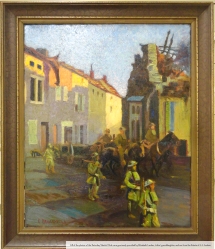 In our upcoming World War I exhibit, “For Home and Country”, we will be featuring an oil painting by Lt. Clement C. Beuchat, entitled “78 Lightening Division at Thiaucourt, France, 1918”. This piece depicts a group of World War I soldiers on horseback in the town of Thiaucourt, France, most likely illustrating the remains of the town during or after the Battle of Saint-Mihiel.
In our upcoming World War I exhibit, “For Home and Country”, we will be featuring an oil painting by Lt. Clement C. Beuchat, entitled “78 Lightening Division at Thiaucourt, France, 1918”. This piece depicts a group of World War I soldiers on horseback in the town of Thiaucourt, France, most likely illustrating the remains of the town during or after the Battle of Saint-Mihiel.
Clement Beuchat was born in Buffalo, NY on March 28, 1891. He attended the Buffalo Fine Arts Academy and studied under Earnest Fosberry. Beuchat joined the New York National Guard 78th Division. He was involved in the pursuit of Pancho Villa during the Texas Border Campaign from 1914-1917 and he was eventually sent to fight in World War I. Clement continued to paint for the duration of his military service. He painted throughout the Southwest until he was sent to Europe, where he continued his artistic endeavors while stationed in France. Beuchat fought in several major battles during the Great War and received the Victory Medal with three Battle Stars, along with other service awards. He returned home in 1919, where he became a member of the Fine Arts League and continued to paint until his death in 1955.
 While doing the research on this painting and Clement, I learned that Beuchat was an original member of the Saturday Sketch Club in Springbrook, New York along with other artists such as Arthur Kowalski, Harry O’Neill, William J. Schwanekamp, and Julius Lankes.
While doing the research on this painting and Clement, I learned that Beuchat was an original member of the Saturday Sketch Club in Springbrook, New York along with other artists such as Arthur Kowalski, Harry O’Neill, William J. Schwanekamp, and Julius Lankes.  This is notable because there is a sketch box used by Buffalo painter and engraver, J.J Lankes as part of the Saturday Sketch Club, in our collection. The Saturday Sketch Club was formed in reaction to the dismissal of Mr. Earnest Fosberry, an artist and teacher at the Buffalo Fine Arts Academy. A group of students, including those mentioned above, created this art school with Mr. Fosberry as their instructor and critic, as a way to protest the firing of their favorite teacher.
This is notable because there is a sketch box used by Buffalo painter and engraver, J.J Lankes as part of the Saturday Sketch Club, in our collection. The Saturday Sketch Club was formed in reaction to the dismissal of Mr. Earnest Fosberry, an artist and teacher at the Buffalo Fine Arts Academy. A group of students, including those mentioned above, created this art school with Mr. Fosberry as their instructor and critic, as a way to protest the firing of their favorite teacher.

Here is a photo of some of the members of the Saturday Sketch Club of Springbrook, including Beuchat, with his right foot on the step in the center of the picture. Left to right: Thundercloud, a Blackfoot Indian model who served in his early days as scout for Custer’s 7th Cavalry; William J. Schwanekamp; Ernest Fosberry (in Derby hat), instructor; John Kneuhal; Edgar Kowalski; Al Barwell “Shorty”; Jules Meyers; Clement Beuchat (with his right foot on the step in the center of the picture); Myron Moyer; J.J. Lankes; and Harry O’Neill
 The students would meet at a cabin out in Springbrook, NY to immerse themselves in nature. They all had their own sketch boxes with attached seats that were portable and could be carried throughout the surrounding area to set up a painting station wherever they liked. The sketch boxes, like the one in our collection, were made up of wooden boxes attached to wooden folding stools that had multi-colored canvas seats for the artists to sit on while they worked. The boxes opened on metal hinges that locked to create makeshift easels. Inside the box would be all the tools an artist would need including a wooden palette, paints, paintbrushes, and charcoal.
The students would meet at a cabin out in Springbrook, NY to immerse themselves in nature. They all had their own sketch boxes with attached seats that were portable and could be carried throughout the surrounding area to set up a painting station wherever they liked. The sketch boxes, like the one in our collection, were made up of wooden boxes attached to wooden folding stools that had multi-colored canvas seats for the artists to sit on while they worked. The boxes opened on metal hinges that locked to create makeshift easels. Inside the box would be all the tools an artist would need including a wooden palette, paints, paintbrushes, and charcoal.
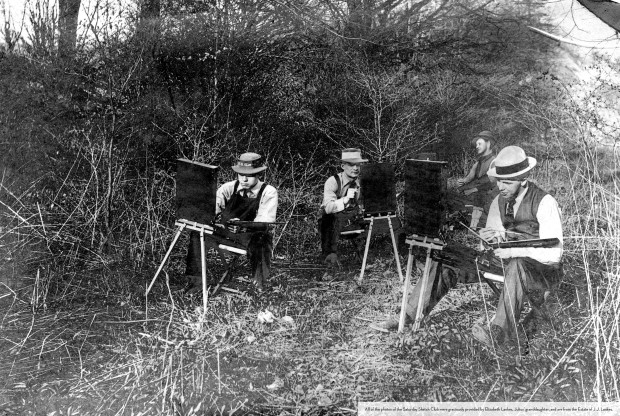
Left to Right: Bill (William) Schwanekamp, J.J. Lankes, Edgar Kowalski, Clement Beuchat
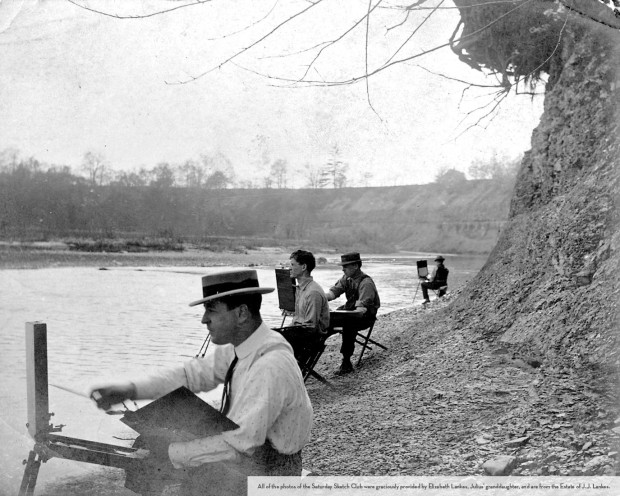
Left to Right: Bill (William) Schwanekamp, J.J. Lankes, Edgar Kowalski, Clement Beuchat
As I transitioned from researching the Clement Beuchat painting to the Saturday Sketch Club, I stumbled upon a large collection of photographs of the original members of the organization, some of which are featured here. Sometimes technology is a wonderful thing and I was able to reach out to Elizabeth Lankes, who uploaded these images to her Flickr account. Elizabeth is the granddaughter of J.J. Lankes and it was so much fun to be able to connect with her. I truly appreciate all of the photos that she sent me and getting to speak with someone who so clearly treasures her family’s history. This is such a wonderful part of my job as the Registrar at The Buffalo History Museum, getting to learn all of these stories, share them with the public, and interact with others who love our history. If you want to see more of these photos you can go to Elizabeth’s Flickr page at https://www.flickr.com/photos/11435178@N03/albums/72157608622346090
All of the photos of the Saturday Sketch Club were graciously provided by Elizabeth Lankes, Julius’ granddaughter, and are from the Estate of J.J. Lankes.
Rebecca Justinger,
Registrar
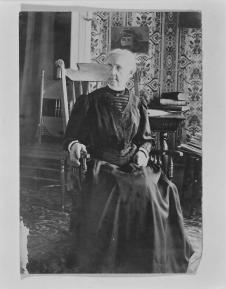 In 1987, Julia Boyer Reinstein, historian and architectural preservationist, donated over 80 quilts and bed coverings to The Buffalo History Museum. Early on in her life, Julia became fascinated with quilts and believed in the importance of documenting their histories. She received a Bachelor’s degree in History from Elmira College for Women in 1928, writing her senior thesis on early American quilts. Beginning her collection with family quilts, she focused her collecting goals on quilts made west of the Genesee River. Remarkably, only twelve of the quilts in her collection were purchased, the rest were given to her as gifts or through inheritance.
In 1987, Julia Boyer Reinstein, historian and architectural preservationist, donated over 80 quilts and bed coverings to The Buffalo History Museum. Early on in her life, Julia became fascinated with quilts and believed in the importance of documenting their histories. She received a Bachelor’s degree in History from Elmira College for Women in 1928, writing her senior thesis on early American quilts. Beginning her collection with family quilts, she focused her collecting goals on quilts made west of the Genesee River. Remarkably, only twelve of the quilts in her collection were purchased, the rest were given to her as gifts or through inheritance. 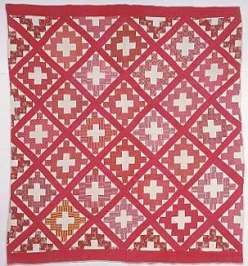 Pictured is a red and white Chimney Sweep quilt from Julia Boyer Reinstein’s quilt collection, also known as an Album or Autograph quilt. It was pieced together by Eliza Graves (later Pickett) between 1852 and 1853, and was assembled and completed in 1854, in Perry, NY. Eliza Graves, pictured above, was Julia Boyer Reinstein’s great grandmother. The Chimney Sweep pattern was very popular for Album quilts in the mid-19th century because a name or inscription could be written on the central cross of each block. According to oral histories from the family, the blocks of this quilt were originally autographed, in pencil, by the young men of Castile, NY.
Pictured is a red and white Chimney Sweep quilt from Julia Boyer Reinstein’s quilt collection, also known as an Album or Autograph quilt. It was pieced together by Eliza Graves (later Pickett) between 1852 and 1853, and was assembled and completed in 1854, in Perry, NY. Eliza Graves, pictured above, was Julia Boyer Reinstein’s great grandmother. The Chimney Sweep pattern was very popular for Album quilts in the mid-19th century because a name or inscription could be written on the central cross of each block. According to oral histories from the family, the blocks of this quilt were originally autographed, in pencil, by the young men of Castile, NY.

 My personal favorites are the newly developed history kits, proven to be an effective teaching tool that students will love; the Native American Kit and the Pioneer Kit have artifacts, reproductions, mini posters and an activity book and are available to rent for your classroom. These kits have been met with rave reviews. You will also have the opportunity to try your luck at identifying an artifact from the early 1800s as you examine our Artifact Detective Program that can be presented at your school.
My personal favorites are the newly developed history kits, proven to be an effective teaching tool that students will love; the Native American Kit and the Pioneer Kit have artifacts, reproductions, mini posters and an activity book and are available to rent for your classroom. These kits have been met with rave reviews. You will also have the opportunity to try your luck at identifying an artifact from the early 1800s as you examine our Artifact Detective Program that can be presented at your school.


 So, what’s happening with it?
So, what’s happening with it? Okay, so there is still a lot of work to be done. Can we still see the Collection even though it isn’t on display?
Okay, so there is still a lot of work to be done. Can we still see the Collection even though it isn’t on display?



















